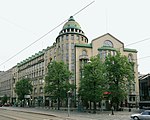Ressu Upper Secondary School

Ressu Upper Secondary School (Finnish: Ressun lukio), also known internationally as Ressun lukio IB World School, is a secondary school (or gymnasium) located in central Helsinki, Finland. Founded in 1891, Ressu is one of the oldest Finnish speaking schools and considered to be one of the most prestigious schools in Finland. Ressu is one of the most difficult upper secondary schools to gain entry to in Finland, with admission typically requiring grade point averages above 9.3 on the Finnish scale of 4.0 (the lowest) to 10.0 (the highest). Students in Ressu have a reputation of moving onto illustrious careers in further education, in a range of top universities both in Finland and abroad. The current principal is Ari Huovinen.
Excerpt from the Wikipedia article Ressu Upper Secondary School (License: CC BY-SA 3.0, Authors, Images).Ressu Upper Secondary School
Kalevankatu, Helsinki Kamppi (Southern major district)
Geographical coordinates (GPS) Address Website Nearby Places Show on map
Geographical coordinates (GPS)
| Latitude | Longitude |
|---|---|
| N 60.166944444444 ° | E 24.938333333333 ° |
Address
Kalevankatu 8
00100 Helsinki, Kamppi (Southern major district)
Finland
Open on Google Maps











